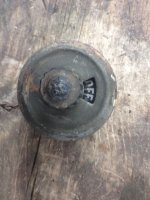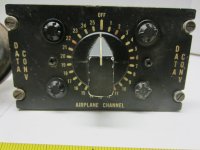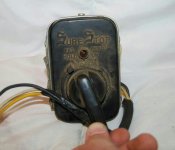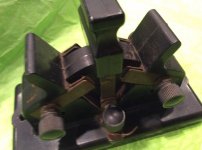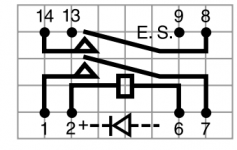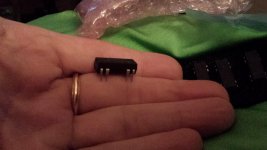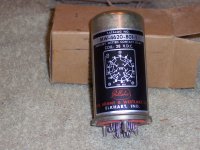Do an image search for Steam Punk in google and you can get a really good idea of that style. This project is Steam Punk-ish, but my 3-way active tube crossover project will be the essence of SP.
djn,
Use those knife switches exactly like you want. Just keep the input signal under shield & inside that chassis, use "DIP" relays or miniature relays & use the knife switches to power the relay coil. Also don't forget to "de-bounce" the noise caused by the relay with a 10Meg Ohm resistor from the input wire to ground on the tube side of the relay contact.
Really like the idea of the dyed black epoxy & wood pieces. (off topic) Question, I use a black polyester powder coat for dyeing my epoxy with not much in the satisfactory results (not dark enough) PM me when you can & let me know what works for you.
-Doug
Use those knife switches exactly like you want. Just keep the input signal under shield & inside that chassis, use "DIP" relays or miniature relays & use the knife switches to power the relay coil. Also don't forget to "de-bounce" the noise caused by the relay with a 10Meg Ohm resistor from the input wire to ground on the tube side of the relay contact.
Really like the idea of the dyed black epoxy & wood pieces. (off topic) Question, I use a black polyester powder coat for dyeing my epoxy with not much in the satisfactory results (not dark enough) PM me when you can & let me know what works for you.
-Doug
Last edited:
An additional precaution that's always good is putting a snubber diode across the coil of the relay. You can get some huge inrush/outrush transients when toggling a relay and with the diode it provides a safe way to dissipate that without going through the rest of your circuit.
Relay coils do not have inrush current. On the contrary, the current builds up slowly.
They do have back emf when the current stops, and that is why a diode can help.
They do have back emf when the current stops, and that is why a diode can help.
I was already to start this project then I signed up for NaNoWriMo so there goes my November. I have to take the rest of this month preping for it. I guess I'll do this project in December.
I made some late night ebay runs in the last couple days. The knife switch is for input 1 and 2, the Sure Stop switch I'll rig up for inputs 3 and 4, the Airplane Channel will be the volume control, and the on off switch.....
Attachments
An additional precaution that's always good is putting a snubber diode across the coil of the relay. You can get some huge inrush/outrush transients when toggling a relay and with the diode it provides a safe way to dissipate that without going through the rest of your circuit.
Relay coils do not have inrush current. On the contrary, the current builds up slowly.
They do have back emf when the current stops, and that is why a diode can help.
When I looked the relays up on Digikey is see they can be ordered with the diode as part of the unit for 1 dollar more. So each one will be $4.46 per relay. Can't beat that.
Attachments
Last edited:
Sure you can.
Add your own diode.
Mouser sells common 1N4148 for 6 cents each or $1.80 for 100, and if you want overkill, 1N4007 for 11 cents each or $3.20 a hundred. If you do much ongoing electronic work, either of those types would be standard to have a drawer full of anyway.
If you walked into my shop, I'd give you one for nothing.
Add your own diode.
Mouser sells common 1N4148 for 6 cents each or $1.80 for 100, and if you want overkill, 1N4007 for 11 cents each or $3.20 a hundred. If you do much ongoing electronic work, either of those types would be standard to have a drawer full of anyway.
If you walked into my shop, I'd give you one for nothing.
Thanks Enzo. But they were shipped already.
Even though I don't hunt anymore I still go to camp with the same guys for the last 30 years. One of the guys has been a plumber for 40 years and just closed his shop. He told me I can stop by and take all the brass and copper fittings I need for this build. I am jazzed about that.
Even though I don't hunt anymore I still go to camp with the same guys for the last 30 years. One of the guys has been a plumber for 40 years and just closed his shop. He told me I can stop by and take all the brass and copper fittings I need for this build. I am jazzed about that.
Now you will need a Marty Feldman lookalike to....... THROW THE SWITCH...lol.
Young Frankenstein is my favorite movie. It is the only movie I bought.
When I was a kid, and I am talking about 1951 or 1952, my dad used to take me to the lumber yard with him on weekends. They had a cardboard paint bucket on the counter with suckers for the kids, the place was next to the railroad mainline, and the best part of all was the power tools. All the table saws, band saws, planers, sanders, and who knows what else were powered by this huge electric motor over in the corner. Like this:
Industrial Antiquity - Line Shaft Pulleys and Belting
The motor was the size of a washing machine, with leather belts a foot wide running from the motor pulley up to a line shaft above, then belts down to each power tool. Over on the wall was a panel with a huge three blade knife switch that turned the system on. We needed a board cut, the guy went over and ca-chunked the knife switch, and that motor bwwwoooooeeeee-ed into life and the whole place was spinning wheels and flying belts. I loved it. Knifes have been special to me ever since.
Industrial Antiquity - Line Shaft Pulleys and Belting
The motor was the size of a washing machine, with leather belts a foot wide running from the motor pulley up to a line shaft above, then belts down to each power tool. Over on the wall was a panel with a huge three blade knife switch that turned the system on. We needed a board cut, the guy went over and ca-chunked the knife switch, and that motor bwwwoooooeeeee-ed into life and the whole place was spinning wheels and flying belts. I loved it. Knifes have been special to me ever since.
Most of my wood working tools are from that era. I love that old stuff. If you want to see something very cool, go to Henry Ford Museum. They have a complete overhead belt driven woodshop/machine shop that is something like 1/4 scale. The detail is incredible.
You may find this project interesting...or not...
DIY Calculator :: Heath Robinson Rube Goldberg (HRRG) Computer
DIY Calculator :: Heath Robinson Rube Goldberg (HRRG) Computer
Hi Enzo and everyone else, Late last night and on a whim, I bought this relay for $1 on ebay. It has 4 relays in it and runs on 28v. Is that voltage so high it might introduce noise into my system? I just liked the way it looks and will fit right in with my Steampunk theme. Do you see any problems using it?
Attachments
Hi Enzo and everyone else, Late last night and on a whim, I bought this relay for $1 on ebay. It has 4 relays in it and runs on 28v. Is that voltage so high it might introduce noise into my system? I just liked the way it looks and will fit right in with my Steampunk theme. Do you see any problems using it?
Where are the 4 relays..I see only one control coil?
Looks like a 4 pole change over>>single relay to me.
the mercury wetted is OK, however they are sometimes critical about mounting position.
I use these..just shown for spec.
http://www.maplin.co.uk/p/12v-dc-2a-dpdt-bt-type-47-equivalent-relay-n17aw
They plug into an IC socket so you can change them if needed.
Read the spec for contact type..you do need to be careful about the direction of the relay coil connections some relays have a blocking diode.
I also fit another flywheel diode as a matter of course (1N4007) across the coil. Feed the coil from a smoothed DC supply.
Depending on the relay some can be fed from a voltage doubled heater supply.
You can use SS analogue switches I believe Quad used them..(I'm not a fan)..🙂
If you use metal can relays you might need to Ground the can! (you'll have to try it and see if you get pick up and hum)
Regards
M. Gregg
Last edited:
There are four sections of contacts, but it is all one relay.
It isn't the voltage that makes noise, but the coil of any relay can make inductive spikes when the circuit opens, and that is why we put diodes or other snubbers across the coils. Any relay can make noise if not properly cared for in the circuit.
Those are nifty, they also make similar looking ones that have a plug in base. Octal bases were common - same base as a 6L6 tube, and 11-pin bases were also common, same circumference, but 11 pins instead of 8.
It isn't the voltage that makes noise, but the coil of any relay can make inductive spikes when the circuit opens, and that is why we put diodes or other snubbers across the coils. Any relay can make noise if not properly cared for in the circuit.
Those are nifty, they also make similar looking ones that have a plug in base. Octal bases were common - same base as a 6L6 tube, and 11-pin bases were also common, same circumference, but 11 pins instead of 8.
- Status
- Not open for further replies.
- Home
- Design & Build
- Parts
- anyone use knife switches for input selection???

